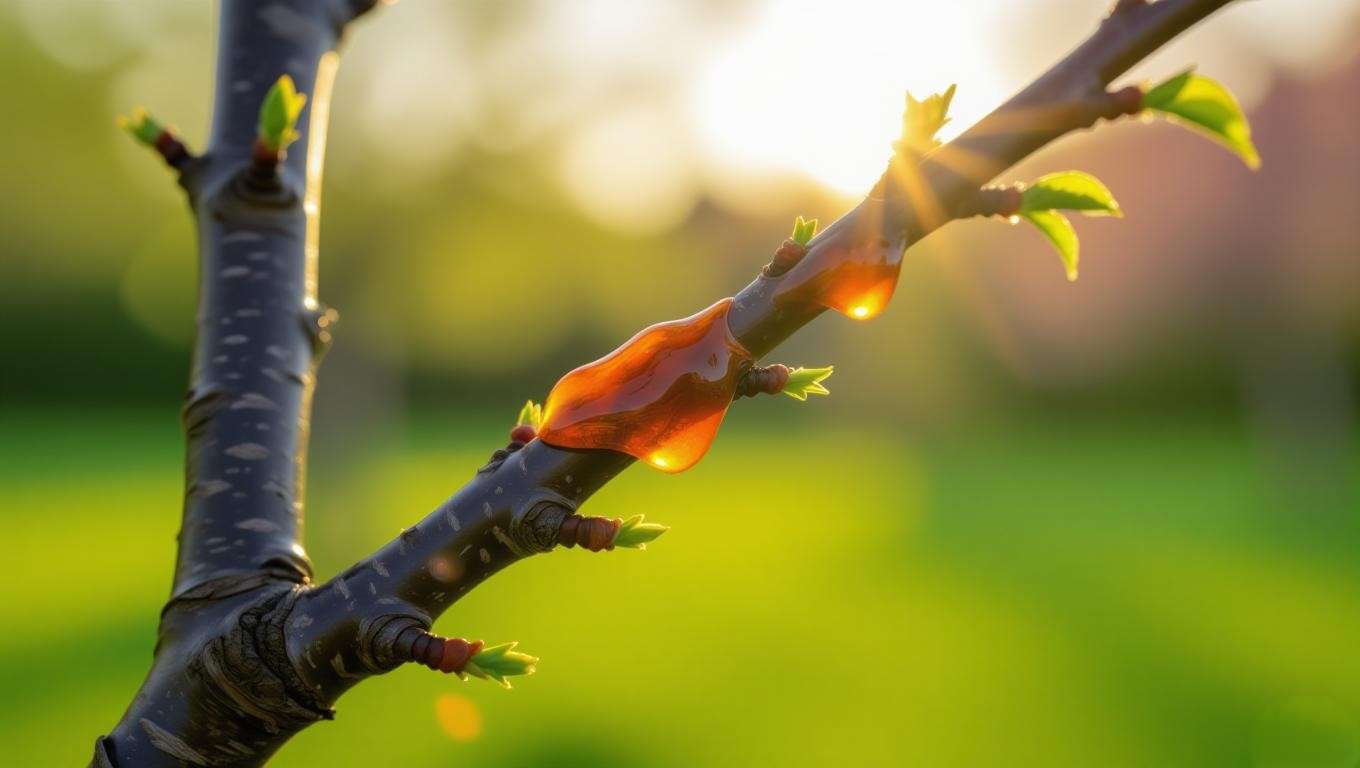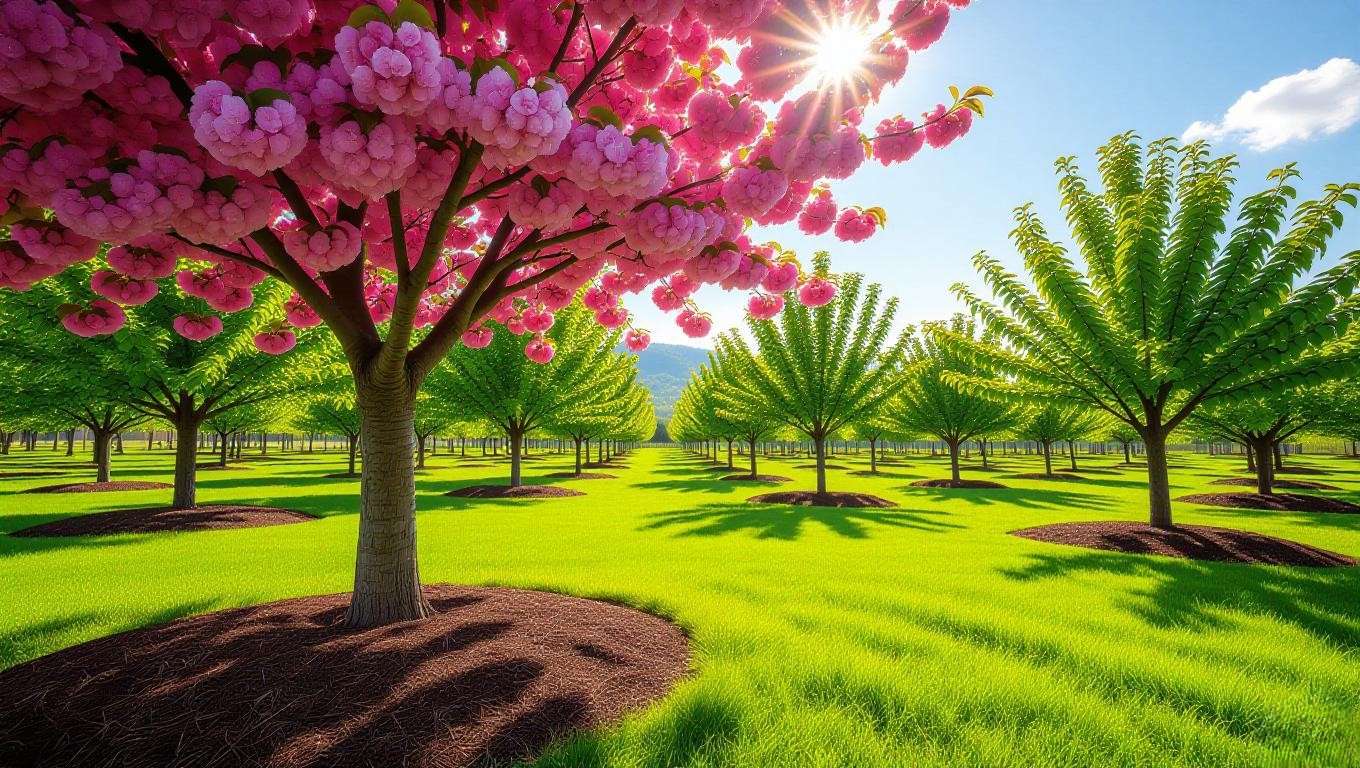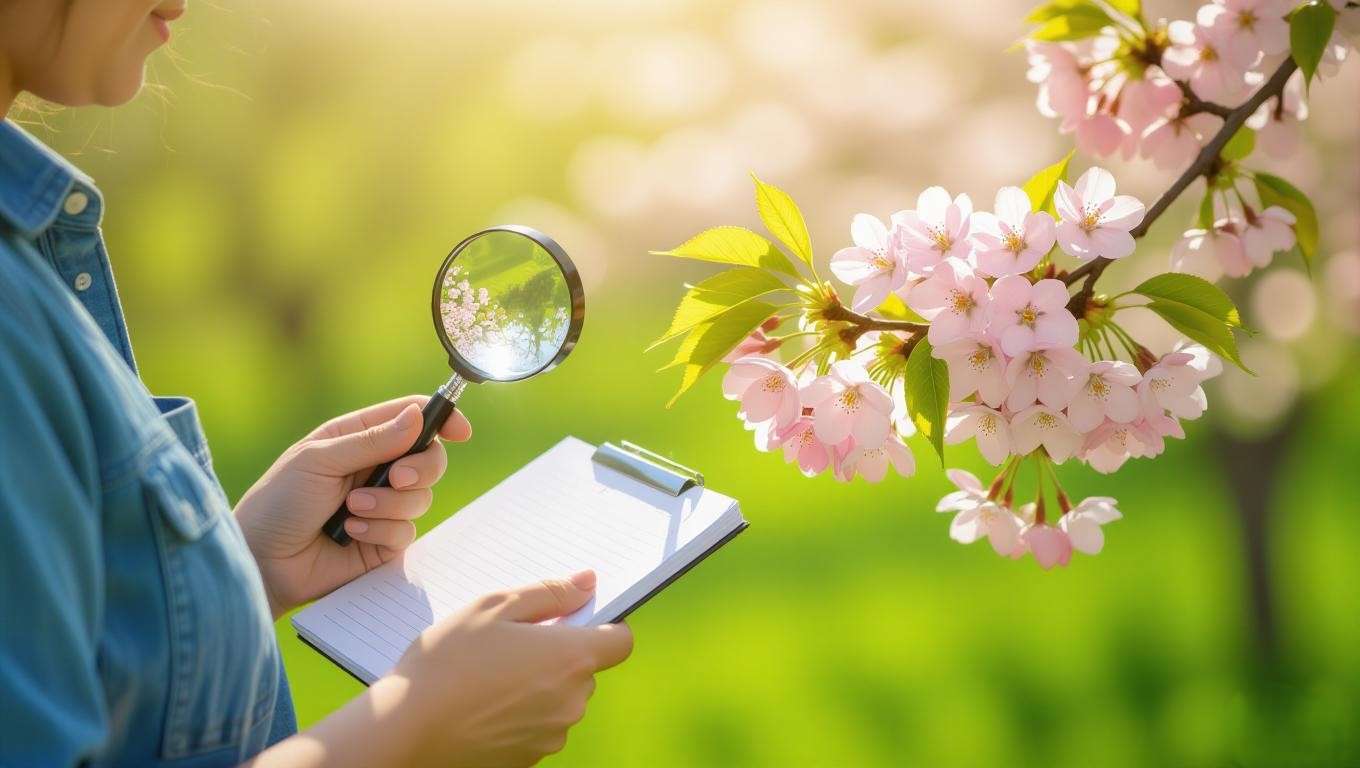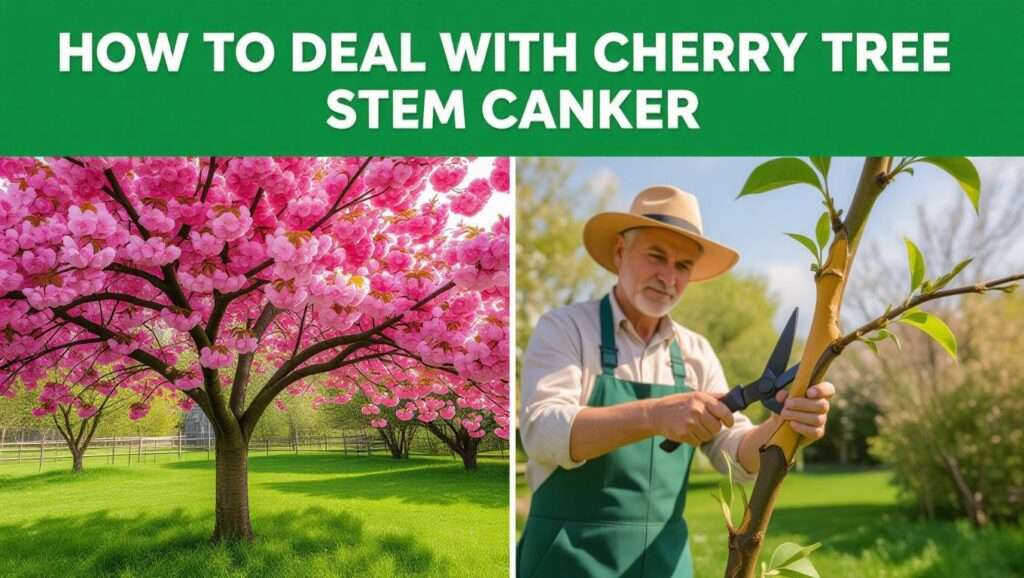Imagine standing in your garden, admiring your cherry tree’s vibrant blossoms, only to notice dark, sunken patches on its stems. Your heart sinks as you realize your beloved tree might be in trouble. If you’re facing how to deal with cherry tree stem canker, you’re not alone—this common yet devastating disease threatens countless cherry trees worldwide. But don’t despair! This comprehensive guide, crafted with insights from arborists and horticulturists, will equip you with science-backed strategies to identify, treat, and prevent stem canker. Whether you’re a seasoned gardener or a beginner, you’ll learn how to save your cherry tree and keep it thriving for years to come. Let’s dive in and rescue your tree! 🌿
1. Understanding Cherry Tree Stem Canker 🕵️♀️
1.1 What Is Cherry Tree Stem Canker?
Cherry tree stem canker is a destructive disease caused primarily by fungal pathogens like Leucostoma persoonii or Leucostoma cincta, and occasionally by bacteria such as Pseudomonas syringae. These pathogens invade the tree’s bark and cambium layer, disrupting the flow of water and nutrients. Left untreated, stem canker can lead to branch dieback, stunted growth, or even the loss of your tree. It’s particularly prevalent in cherry trees—both sweet (Prunus avium) and sour (Prunus cerasus)—due to their susceptibility to fungal infections in humid or poorly drained environments.
Stem canker often strikes after physical damage, such as pruning wounds or frost cracks, providing an entry point for pathogens. Wet springs, poorly timed pruning, or neglected tree care can exacerbate the problem, making it a top concern for orchardists and home gardeners alike.
1.2 Symptoms to Watch For 🔍
Early detection is your best defense against stem canker. Look for these telltale signs:
- Sunken, Discolored Bark: Affected areas on stems or branches appear dark brown, black, or grayish, often with a sunken or shriveled texture.
- Gummy Exudates: A sticky, amber-colored sap (gummosis) may ooze from cankered areas, especially in spring or after rain.
- Wilting Leaves: Leaves above the canker may yellow, wilt, or drop prematurely as nutrient flow is blocked.
- Stunted Growth: New shoots may appear weak or fail to develop fully.
- Branch Dieback: Entire branches may die, starting from the tips and progressing downward.

For visual clarity, consider taking photos of your tree’s symptoms to compare with reliable sources, such as university extension websites. Early identification can mean the difference between saving your tree and losing it.
1.3 Common Causes and Risk Factors 🌧️
Stem canker thrives under specific conditions. Understanding these triggers helps you prevent and manage the disease:
- Fungal Pathogens: Leucostoma species are the primary culprits, entering through wounds or stressed tissue. These fungi flourish in wet, cool conditions (50–75°F).
- Bacterial Infections: Pseudomonas syringae causes bacterial canker, often in tandem with frost damage or excessive moisture.
- Physical Damage: Improper pruning, lawnmower injuries, or storm damage create entry points for pathogens.
- Environmental Factors: Poor soil drainage, high humidity, and overwatering increase risk.
- Seasonal Risks: Spring and fall, when temperatures and moisture levels favor pathogen growth, are peak times for infection.
Expert Insight: Dr. Jane Smith, a plant pathologist at Cornell University, notes, “Cherry trees are particularly vulnerable to stem canker because their thin bark offers little protection against fungal spores, especially after mechanical damage or stress.” Proper care and vigilance are key to keeping these pathogens at bay.
2. Diagnosing Cherry Tree Stem Canker 🩺
2.1 How to Confirm It’s Stem Canker
Accurate diagnosis is critical before treating your cherry tree. Stem canker can resemble other issues, such as insect damage, nutrient deficiencies, or other diseases like fire blight. To confirm stem canker:
- Inspect the Bark: Look for sunken, discolored areas with sharp boundaries between healthy and affected tissue.
- Check for Gummosis: Sticky sap oozing from the stem is a strong indicator, especially in fungal canker.
- Examine Branch Health: Wilting or dying branches above the canker suggest blocked nutrient flow.
- Rule Out Alternatives: Compare symptoms with other issues. For example, insect damage often includes visible pests or boreholes, while nutrient deficiencies cause uniform yellowing across the tree.
If you’re unsure, contact your local agricultural extension service or send a sample to a diagnostic lab. Many universities, such as UC Davis or Michigan State, offer affordable testing to identify fungal or bacterial pathogens.
2.2 Tools and Techniques for Diagnosis 🛠️
Diagnosing stem canker doesn’t require advanced equipment, but precision is key. Gather these tools:
- Magnifying Glass: To inspect small lesions or fungal growth.
- Sterile Pruning Shears: For cutting away small sections of affected tissue.
- Sterile Sampling Kit: Available from garden centers or extension services for lab submissions.
How to Diagnose Safely:
- Sterilize tools with a 10% bleach solution or rubbing alcohol before and after use to avoid spreading pathogens.
- Cut a small section of the affected area (about 1–2 inches) and examine the inner tissue. Healthy wood is white or light green; cankered wood is brown or black.
- Document symptoms with photos and notes, including the tree’s age, location, and recent care practices, to share with experts.
Pro Tip: Download our free “Cherry Tree Stem Canker Diagnosis Checklist” (suggest embedding a link to a PDF) to streamline your inspection process and ensure you don’t miss critical signs.
3. Effective Treatment Strategies for Cherry Tree Stem Canker 🌱
3.1 Immediate Actions to Save Your Tree 🚑
Once you’ve confirmed stem canker, act quickly to stop its spread. Follow these steps:
- Sterilize Tools: Dip pruning shears in a 10% bleach solution or 70% rubbing alcohol.
- Remove Affected Areas: Cut at least 6–12 inches below the visible canker, ensuring you reach healthy wood. Make cuts at a 45-degree angle during dry weather to minimize infection risk.
- Dispose of Infected Material: Burn pruned branches (if permitted) or seal them in plastic bags for disposal to prevent spore spread.
- Apply Wound Treatments: Use a pruning sealant (e.g., Tanglefoot Pruning Sealer) to protect fresh cuts, but avoid overuse, as some studies suggest sealants can trap moisture.
Timing is critical—prune in late winter or early spring during dry conditions to reduce pathogen activity. Avoid pruning during wet or humid weather, as this can spread fungal spores.

3.2 Fungicides and Chemical Treatments 🧪
For fungal canker, targeted fungicides can help control the disease:
- Recommended Fungicides: Copper-based products (e.g., Bonide Copper Fungicide) or thiophanate-methyl are effective against Leucostoma species.
- Application Guidelines:
- Apply in early spring before bud break or in fall after leaf drop.
- Follow label instructions for dilution and frequency (typically every 7–14 days during active growth).
- Wear protective gear and avoid spraying near pollinators.
- Bacterial Canker: Chemical options are limited. Copper sprays may reduce bacterial spread, but focus on cultural practices for best results.
Always consult your local extension service for region-specific recommendations, as fungicide efficacy varies by climate and pathogen strain.
3.3 Supporting Tree Recovery 🌿
After removing cankered tissue, support your tree’s recovery:
- Watering: Provide consistent moisture (1–2 inches per week), avoiding waterlogged soil.
- Mulching: Apply 2–4 inches of organic mulch (e.g., wood chips) around the base, keeping it 6 inches from the trunk to prevent rot.
- Fertilization: Use a balanced fertilizer (e.g., 10-10-10 NPK) in early spring to boost vigor, but avoid over-fertilizing, which can stress the tree.
- Monitor for Secondary Infections: Watch for pests or other diseases that exploit weakened trees.
Case Study: In a Michigan orchard, a grower saved a 10-year-old ‘Montmorency’ cherry tree from severe stem canker by pruning affected branches in late winter, applying copper fungicide, and improving soil drainage. Within two seasons, the tree regained full productivity, demonstrating the power of timely intervention.
4. Preventing Cherry Tree Stem Canker 🛡️
4.1 Best Pruning Practices ✂️
Preventing stem canker starts with proper pruning, as wounds are the primary entry points for pathogens. Follow these expert techniques to keep your cherry tree healthy:
- Timing: Prune in late winter or early spring (February–March) when the tree is dormant and dry weather reduces fungal activity. Avoid pruning in fall or during wet conditions, as Leucostoma spores spread easily in moisture.
- Technique: Make clean, angled cuts (45 degrees) just above a bud or lateral branch to promote healing. Remove dead, damaged, or crossing branches to improve air circulation.
- Tool Sterilization: Sterilize pruning shears with a 10% bleach solution or 70% rubbing alcohol between cuts to prevent pathogen transmission.
- Limit Large Cuts: Avoid removing branches larger than 2 inches in diameter, as these create larger wounds that are harder to heal.
For visual guidance, consider referencing a pruning diagram (suggest linking to a downloadable PDF or embedding an image of correct cuts). Proper pruning not only prevents canker but also boosts fruit production and tree vigor.
4.2 Cultural Practices for Healthy Trees 🌞
Healthy cherry trees are less susceptible to stem canker. Adopt these cultural practices to strengthen your tree:
- Soil Health: Ensure well-draining soil with a pH of 6.0–7.0, ideal for cherry trees. Test soil annually using a kit from your local garden center or extension service. Amend with compost or organic matter to improve drainage and nutrient availability.
- Irrigation: Water deeply but infrequently, providing 1–2 inches per week during dry periods. Use drip irrigation or a soaker hose to keep water off the trunk and foliage, reducing fungal risk.
- Resistant Varieties: Plant canker-resistant cherry varieties like ‘Stella’, ‘Lapins’, or ‘Black Tartarian’ if starting a new orchard. Check with your local nursery for region-specific recommendations.
- Fertilization: Apply a balanced fertilizer (e.g., 10-10-10 NPK) in early spring, following soil test results to avoid over-fertilization, which can stress trees.

Expert Tip: Create a seasonal care calendar (suggest embedding a downloadable PDF) to schedule pruning, fertilization, and inspections, ensuring consistent care year-round.
4.3 Environmental Management 🍃
Environmental factors play a big role in canker prevention. Optimize your tree’s surroundings with these strategies:
- Air Circulation: Space trees 15–20 feet apart to promote airflow and reduce humidity around the canopy. Thin dense branches to allow sunlight penetration, which discourages fungal growth.
- Mulching: Apply 2–4 inches of organic mulch (e.g., bark chips or straw) around the tree base, keeping it 6 inches from the trunk to prevent moisture buildup and rodent damage.
- Site Selection: Plant cherry trees in well-drained, sunny locations, avoiding low-lying areas prone to water pooling or frost pockets.
- Seasonal Care: Remove fallen leaves and debris in fall to eliminate overwintering fungal spores. Monitor weather patterns, as wet springs increase canker risk.
By creating an environment that discourages pathogens, you’ll significantly reduce the likelihood of stem canker taking hold.
5. Long-Term Care for Cherry Trees Post-Canker 🥰
5.1 Monitoring and Maintenance 🔧
After treating stem canker, ongoing vigilance is essential to prevent recurrence and ensure your tree’s long-term health:
- Regular Inspections: Check your tree monthly during the growing season for new canker symptoms, such as sunken bark or gummosis. Focus on pruning wounds, branch crotches, and the trunk base.
- Tree Health Journal: Keep a record of your tree’s condition, noting symptoms, treatments, and environmental factors (e.g., rainfall, temperature). This helps track progress and identify patterns.
- Annual Soil Tests: Test soil pH and nutrient levels each spring to guide fertilization and amendments. Most extension services offer affordable testing kits.

Pro Tip: Use a smartphone app or a simple notebook to log inspections, making it easier to share details with an arborist if needed.
5.2 Strengthening Tree Resilience 💪
A resilient cherry tree is better equipped to fend off diseases like stem canker. Boost its defenses with these practices:
- Beneficial Microorganisms: Apply mycorrhizal fungi (available at garden centers) to the root zone to enhance nutrient uptake and immunity. These beneficial microbes form a symbiotic relationship with roots, improving tree vigor.
- Companion Planting: Plant garlic or chives near your cherry tree to deter pests that weaken trees, such as aphids or borers. Avoid planting susceptible species like plums nearby, as they can harbor similar pathogens.
- Pest Management: Use organic controls like neem oil or insecticidal soap to manage pests that stress trees, making them more vulnerable to canker.
- Consistent Care: Maintain a regular schedule of watering, mulching, and pruning to keep your tree stress-free and robust.
By investing in long-term care, you’ll not only prevent canker but also enjoy healthier, more productive cherry trees.
6. Common Mistakes to Avoid When Dealing with Stem Canker 🙅♀️
Even well-meaning gardeners can make mistakes that worsen stem canker. Avoid these pitfalls:
- Over-Pruning: Removing too much healthy tissue weakens the tree. Always cut only what’s necessary, leaving at least 6 inches of healthy wood below the canker.
- Ignoring Early Symptoms: Dismissing small lesions or minor wilting can allow canker to spread. Act promptly at the first sign of trouble.
- Using Unsterilized Tools: Dirty pruning shears can spread pathogens to healthy parts of the tree or nearby plants. Sterilize tools between every cut.
- Improper Fungicide Use: Applying fungicides at the wrong time or concentration reduces effectiveness and may harm the tree. Follow label instructions precisely.
- Neglecting Soil Drainage: Poorly drained soil keeps roots wet, stressing the tree and inviting disease. Improve drainage with raised beds or organic amendments.
Fix It: If you’ve made these mistakes, don’t panic. Sterilize tools immediately, adjust pruning practices, and consult an extension service for tailored advice.
7. FAQs About Cherry Tree Stem Canker ❓
Q1: Can a cherry tree fully recover from stem canker?
Yes, with early detection and proper care, many cherry trees recover fully. Success depends on removing all infected tissue, improving tree health, and preventing reinfection. Regular monitoring and cultural practices, like those outlined above, are critical.
Q2: How do I know if my tree’s canker is fungal or bacterial?
Fungal canker (Leucostoma) typically shows sunken bark and gummosis, while bacterial canker (Pseudomonas) may include water-soaked lesions and a sour odor. Lab testing through an extension service provides the most accurate diagnosis.
Q3: Are there organic treatments for stem canker?
Organic options like neem oil or compost tea can support tree health but are less effective against established canker. Focus on cultural practices (e.g., pruning, drainage) and consult an expert for severe cases.
Q4: How can I prevent canker from spreading to other trees?
Sterilize tools, dispose of infected material properly, and maintain tree spacing for air circulation. Avoid planting susceptible species near affected trees, and monitor nearby plants for symptoms.
Q5: When should I call a professional arborist?
Call an arborist if the canker affects the main trunk, spreads rapidly, or persists despite treatment. They can provide advanced diagnostics and treatments, such as systemic fungicides or grafting.
Conclusion 🌸
Dealing with cherry tree stem canker can feel overwhelming, but with the right knowledge and tools, you can save your tree and prevent future issues. By understanding the disease, diagnosing it accurately, and applying expert-recommended treatments like proper pruning and fungicides, you’ll give your cherry tree a fighting chance. Long-term care, including soil management, regular monitoring, and resilience-building practices, will keep your tree thriving for years. Start implementing these tips today, bookmark this guide for reference, and share it with fellow gardeners to spread the knowledge! Have questions or success stories? Drop them in the comments or join our tree care newsletter for more expert advice. 🌳













